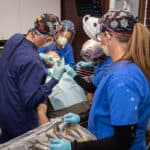The Day Of Your Wisdom Teeth Removal – Part 2
What to Expect When You Have Your Wisdom Teeth Extracted
Last time, we started our discussion about wisdom teeth removal surgery preparation. After fasting, providing informed consent and starting an intravenous line, the patient will be ready for sedation.
Unlike major surgeries, my procedure does not require placement of a breathing tube. Instead, patients simply receive an IV injection of drugs that have a proven safety record and are used in hospitals thousands of times a day.
I typically use a drug called Midazolam, followed by Propofol, which will be delivered based on the individual patient’s needs, weight, vital signs, and the length of the procedure.

During the procedure, small additional doses will be administered in order to maintain the proper level of sedation. The effects of these drugs will begin to wear off as the procedure is coming to a close, and most patients will be able to walk on their own within 15 minutes.
Within about 24 hours, patients will be feeling entirely normal.
We will also administer Atropine or Glycopyrrolate through the IV line, which are drugs that decrease salivary flow. Decreased salivary flow makes the procedure easier and safer by eliminating the risk of inhaling saliva while under sedation.
In addition, we administer medications to reduce post-operative pain, and a nonsteroidal anti-inflammatory known as Ketorolac. Most patients will also receive a steroid anti-inflammatory to help reduce swelling.
Even though the patient will be sedate and receive pain medication during the procedure, a shot of local anesthetic will be administered prior to initiating the procedure. This is done for two reasons, one of which is the fact that regardless of how deeply sedated the patient is, they can still sense pressure and pain during the procedure.
Upon waking, the patient will have no recollection of sensing pain during the procedure, but that doesn’t mean that they won’t have moved during the procedure in response to the pain.
Operating without a l0ocal anesthetic requires higher doses of sedatives to keep the patient asleep, and practicing responsible medicine means delivering the smallest dose of sedative medications as needed.
The second reason I use a local anesthetic is to ease the recovery process. Local anesthesia causes the patient to remain numb for one to two hours after the procedure, which allows them enough time to make it home and begin the prescribed medications.
In a future blog, we’ll discuss the wisdom teeth removal process…
If you’d like to schedule your initial consultation for wisdom teeth removal, please click here.
For more details, see Dr. Babiuk’s book, “What Every Parent Of An Adolescent Needs To Know About Opioids,” available on Amazon.